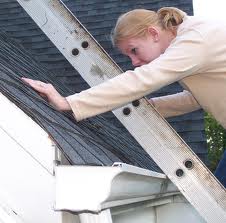Inspecting Your Roof After a Hurricane, Where to Look for Roofing Damages
 Inspecting your roof after a hurricane is vitally important. You want to find and fix any damage as quickly as possible so your roof isn’t vulnerable to the next rain storm. After a hurricane, tropical storm or other high-winds event, a DIY roof check should be done within a couple days. We at Roofing Tutor created this quick check list for you to use. It is designed to remind you of the little things and big ones that you should look at right after the storm has passed.
Inspecting your roof after a hurricane is vitally important. You want to find and fix any damage as quickly as possible so your roof isn’t vulnerable to the next rain storm. After a hurricane, tropical storm or other high-winds event, a DIY roof check should be done within a couple days. We at Roofing Tutor created this quick check list for you to use. It is designed to remind you of the little things and big ones that you should look at right after the storm has passed.
How to Inspect Your Roof after a Hurricane
It’s possible to inspect the roof from the ground if you can stand back far enough to see it. A pair of binoculars is very helpful. If you’ve got a large, stable ladder, leaning it against the eaves and checking the roof from it can also work well. Avoid getting on the roof in case there are loose shingles or other damage which could cause you to lose your footing.
How to Inspect Shingles
Look for missing shingles to start with. They’re easy to spot. Then, look for shingles that have been damaged by having the lower section blown upward. Shingles that are sticking up or bent may be cracked. Any missing or damaged shingles should be replaced as soon as possible.
If hail, tree branches or other debris was blown against the roof, check for places it may have penetrated the roofing material. Holes in shingles can be hard to spot, so inspect closely.
Take this same approach whether you’ve got shingles or other types of roofing. Wood shingles and shakes can be blown off or cracked. Clay tiles are often broken by wind-driven debris. Metal roofing usually holds up well but can be damaged by large tree branches.
How to Spot Leaking Flashing
In high winds, flashing may be displaced or pulled away from the wall, allowing water access to the roof deck or attic. If flashing is not secure to the wall and in uniform position, it might be damaged. Replacing the flashing is preferable to trying to fix it or caulk a gap in flashing.
Check your Attic for Signs of a Leak
Take a flashlight and look into your attic. Check for wet areas on the underside of the roof sheathing or down the sides of the wall. These indicate a leak. Note the position of the leak and then try to identify the roof damage from outside.
Inspect Gutters
Check to see if the gutters are still secure to the eaves. Look for leaks or breaks in the gutter. This may not seem essential, but it is. When a large amount of water from the roof is dumped next to your home’s foundation, it can result in basement leaks.
Summary
The sooner you do a DIY inspection of your roof after a hurricane or major storm, the more quickly the roof can be repaired and your home protected from further damage.
